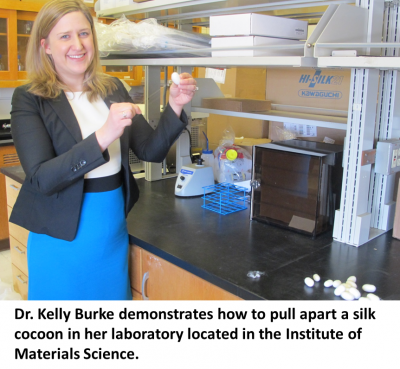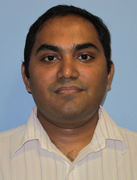
By: Taylor Caron
The Chemical Engineering Department is pleased to announce Matt Stuber as an Assistant Professor whose research focus will be on process systems and optimization.
Professor Stuber received his PhD in Chemical Engineering from MIT, and co-founded a company called WaterFX which is about making conventional approaches to water desalination more efficient and powered by renewables. He said that his work in the private sector was great experience as Director of Process Systems Engineering, and that he is excited to make the shift to academia to continue working on important challenges concerning sustainability and energy.
“WaterFX has been very successful, but I didn’t really find passion in its administration. I’m a scientist and an engineer,” Stuber said. “Sometimes too much of the tech industry is based on growth trajectories and not solving real problems. I decided to refocus my efforts on research and am very pleased to become a member of UConn’s CBE faculty.”
WaterFX, where Stuber led the efforts in all things technical, has gained much attention from national outlets like PBS, National Geographic, and even involvement with The White House, helping shape their efforts in addressing national water challenges. However, Professor Stuber is excited to work with UConn’s Institute for Advanced Systems Engineering which aligns with his experience and interests.
“The new institute has emphasized the kind of research values I consider really important. It’s a great up -and -coming institute which will be a massive force to be reckoned with,” he said.
Professor Stuber’s work at MIT focused on researching and developing theoretical mathematical tools for chemical and energy processes. His research was highly mathematical and he developed algorithms for advanced formal methods in robust and optimal design under uncertainty problems.
Professor Stuber’s research at UConn will continue to focus on process systems engineering, and in particular, rigorous design under uncertainty.
“Process systems is sort of a broad buzz word. It’s a subject of applied mathematics, computer science, and engineering. It applies systems-level thinking to engineered processes,” he said.
Professor Stuber said that his research will be somewhat similar to his work with WaterFx where he developed models and used advanced optimization methods to innovate processes for enhancing efficiency and augmenting them for renewable energy. The company’s ultimate goal is to reduce costs and enhance access to scarce natural resources through sustainable means.
“I’m definitely interested in solving real world problems. Water scarcity is directly related to issues of climate change which is a big part of what attracted me to the issue,” he said. “I’m incredibly glad to be a part of the CBE department to continue to progress this work which has timely and significant benefits to most industries as well as the natural environment.”





 In 2003, researchers realized that green algae respond to high intensities of light using ion channels that sense blue light. The light-activated channels allow ions to flow through the cell membrane, resulting in the initiation of electrical signals called action potentials in neurons. This finding signifies that light energy can be used to trigger electric signals in specific populations of neurons.
In 2003, researchers realized that green algae respond to high intensities of light using ion channels that sense blue light. The light-activated channels allow ions to flow through the cell membrane, resulting in the initiation of electrical signals called action potentials in neurons. This finding signifies that light energy can be used to trigger electric signals in specific populations of neurons. Kelly Burke joins the Chemical & Biomolecular Engineering Department, and has an appointment in the Polymer Program of the Institute of Materials Science. Dr. Burke, who joins UConn under the Eminent Faculty Initiative, earned her PhD at Case Western Reserve University in 2010 and brings expertise in protein modification strategies, tissue engineering, structure-property relationships of liquid crystals, and biocompatible multifunctional polymeric materials. Dr. Burke was a post-doctoral associate at Tufts University (2010-13), where she received an NIH National Research Service Award Fellowship.
Kelly Burke joins the Chemical & Biomolecular Engineering Department, and has an appointment in the Polymer Program of the Institute of Materials Science. Dr. Burke, who joins UConn under the Eminent Faculty Initiative, earned her PhD at Case Western Reserve University in 2010 and brings expertise in protein modification strategies, tissue engineering, structure-property relationships of liquid crystals, and biocompatible multifunctional polymeric materials. Dr. Burke was a post-doctoral associate at Tufts University (2010-13), where she received an NIH National Research Service Award Fellowship. Yongku Cho joins the Chemical & Biomolecular Engineering Department. He received his PhD from the University of Wisconsin – Madison in 2010. Dr. Cho’s research centers on protein engineering, optogenetics, neuroimaging and molecular neurobiology. He was most recently a post-doctoral researcher at the Massachusetts Institute of Technology, where his work involved the molecular engineering of light-activated proteins.
Yongku Cho joins the Chemical & Biomolecular Engineering Department. He received his PhD from the University of Wisconsin – Madison in 2010. Dr. Cho’s research centers on protein engineering, optogenetics, neuroimaging and molecular neurobiology. He was most recently a post-doctoral researcher at the Massachusetts Institute of Technology, where his work involved the molecular engineering of light-activated proteins. Luyi Sun joins the Chemical & Biomolecular Engineering Department, and has an appointment in the Polymer Program of the Institute of Materials Science. Dr. Sun, who joins UConn under the Eminent Faculty Initiative, received his PhD at the University of Alabama in 2004 and brings expertise in multi-functional nanostructured materials; polymeric materials and new polymer processing development; layered compounds; green science and engineering; hydrates and porous materials for energy storage. He was an assistant professor of chemistry at Texas State University (2009-13) and was a post-doctoral fellow at both Texas A&M and the University of Alabama.
Luyi Sun joins the Chemical & Biomolecular Engineering Department, and has an appointment in the Polymer Program of the Institute of Materials Science. Dr. Sun, who joins UConn under the Eminent Faculty Initiative, received his PhD at the University of Alabama in 2004 and brings expertise in multi-functional nanostructured materials; polymeric materials and new polymer processing development; layered compounds; green science and engineering; hydrates and porous materials for energy storage. He was an assistant professor of chemistry at Texas State University (2009-13) and was a post-doctoral fellow at both Texas A&M and the University of Alabama. Julia Valla joins the Chemical & Biomolecular Engineering Department with expertise in the design and development of novel catalysts for industrial applications and design of new, emerging technologies and processes for the clean and sustainable energy production. She earned her PhD at Aristotle University of Thessaloniki, Greece in 2005. Dr. Valla was previously an assistant research professor in CMBE and the Center for Clean Energy Engineering and, earlier in her career, a Project Leader for Rive Technology Inc.
Julia Valla joins the Chemical & Biomolecular Engineering Department with expertise in the design and development of novel catalysts for industrial applications and design of new, emerging technologies and processes for the clean and sustainable energy production. She earned her PhD at Aristotle University of Thessaloniki, Greece in 2005. Dr. Valla was previously an assistant research professor in CMBE and the Center for Clean Energy Engineering and, earlier in her career, a Project Leader for Rive Technology Inc. Kristina Wagstrom joins the Chemical & Biomolecular Engineering Department as the Northeast Utilities Assistant Professor of Environmental Engineering Education. She brings expertise in sourcing and modeling atmospheric particulates, air pollutants, health impacts of atmospheric particulate matter deposition, and air quality models. Dr. Wagstrom received her PhD from Carnegie Mellon University in 2009. She conducted post-doctoral research at the University of Minnesota (2009-12), and was an AAAS Science and Technology Policy Fellow at the U.S. EPA (2012-13).
Kristina Wagstrom joins the Chemical & Biomolecular Engineering Department as the Northeast Utilities Assistant Professor of Environmental Engineering Education. She brings expertise in sourcing and modeling atmospheric particulates, air pollutants, health impacts of atmospheric particulate matter deposition, and air quality models. Dr. Wagstrom received her PhD from Carnegie Mellon University in 2009. She conducted post-doctoral research at the University of Minnesota (2009-12), and was an AAAS Science and Technology Policy Fellow at the U.S. EPA (2012-13).

